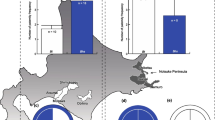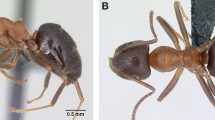Abstract
Queen mating frequency was studied in the European hornet, Vespa crabro, by analyzing four DNA microsatellite loci in 20 workers from each of 14 nests. Queens were found to be predominantly singly mated (9/14), although double (4/14) and triple mating (1/14) also occurred. For most multiply mated queens, paternity was significantly biased with the majority male fathering on average 80% of the female offspring. The population-wide effective mating frequency was therefore low (1.11), and sister-sister relatedness high (0.701 ± 0.023 SE). Low effective mating frequency in Vespa, in combination with data from other vespines, suggests that high paternity frequency is derived in the group. Some problems with the non-detection of fathers, where the queen was not sampled or shared alleles with males, are analyzed.
Similar content being viewed by others
Author information
Authors and Affiliations
Additional information
Received: 16 November 1998 / Received in revised form: 29 March 1999 / Accepted: 12 April 1999
Rights and permissions
About this article
Cite this article
Foster, K., Seppä, P., Ratnieks, F. et al. Low paternity in the hornet Vespa crabro indicates that multiple mating by queens is derived in vespine wasps. Behav Ecol Sociobiol 46, 252–257 (1999). https://doi.org/10.1007/s002650050617
Issue Date:
DOI: https://doi.org/10.1007/s002650050617




